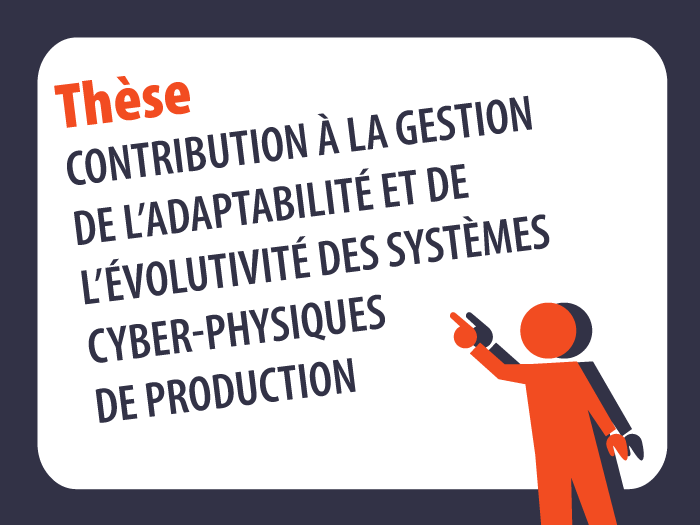
Vendredi 21 octobre 2022, Mme Douha Macherki soutiendra publiquement à ISAE-Supméca ses travaux de thèse intitulés Contribution à la gestion de l’adaptabilité et de l’évolutivité des systèmes cyber-physiques de production (CPPS – Cyber-Physical Production Systems) et dirigés par MM. Jean-Yves CHOLEY (ISAE-Supméca) et Mohamed HADDAR (université de Sfax, École Nationale d’Ingénieur de Sfax, Tunisie)
Résumé
Les systèmes de production doivent s’adapter aux changements internes et externes qui sont de plus en plus fréquents. Grâce à leur capacité d’auto-reconfiguration, les systèmes cyber-physiques de production (CPPS) peuvent faire face à ce besoin d’adaptation. Pour mettre en œuvre cette fonctionnalité d’auto-reconfiguration dans des conditions économiques et sécuritaires satisfaisantes, les CPPS doivent disposer d’outils appropriés et d’informations contextualisées. Ces informations peuvent être organisées sous la forme d’une architecture. Après une analyse de plusieurs architectures holoniques et non holoniques, nous avons proposé une architecture holonique qui permet une reconfiguration fiable et efficace : l’architecture QHAR (Q-Holonic-based ARchitecture). QHAR est construite à partir des Q-Holons. Le Q-Holon est un Holon enrichi ayant quatre dimensions (physique, cyber, humaine et énergétique) et peut échanger trois flux (énergie, donnée et matériel) que nous avons développé. Nous l’avons défini pour être un Holon générique pouvant représenter toute entité ou tout acteur de la chaîne de valeur et capable de représenter tous les flux que ces entités et acteurs peuvent s’échanger. L’architecture QHAR est structurée en trois niveaux : contrôle centralisé, contrôle décentralisé et exécution. En adoptant la philosophe des architectures oligarchiques ou semi-hétérarchique, l’architecture QHAR permet les échanges entre les entités d’un même niveau pour négocier et coopérer. Nous avons ensuite proposé un algorithme de reconfiguration basé sur l’architecture QHAR permettant la mise en œuvre effective de la fonctionnalité d’auto-reconfiguration. Cet algorithme se déroule en trois étapes principales : (1) la détection du besoin de reconfiguration, (2) la détermination des entités nécessaires à la nouvelle configuration et (3) la définition de la nouvelle implémentation. Pour automatiser la vérification des contraintes dans le processus de reconfiguration, nous avons modélisé le problème de reconfiguration à l’aide des équations logiques de la SMT (Satisfaction Modulo Théories). Cette modélisation a consisté essentiellement à la définition de la topologie, de la validité et des missions du système. Les trois contributions précédentes ont été appliquées et testées sur un cas d’étude représentatif des systèmes de production visés.
Mots clés
# Adaptabilité
# Architecture holonique
# CPPS
# Industrie 4.0
# Algorithme de reconfiguration
# Satisfaction Modulo Théories
Abstract
The objective Production systems must adapt to internal and external changes that are becoming more and more frequent. Thanks to their self-reconfiguration capability, cyber-physical production systems (CPPS) can cope with this need to adapt. To implement this self-reconfiguration functionality in a satisfactory economic and security conditions, CPPS must have appropriate tools and contextualized information. This information can be organized in the form of an architecture. After an analysis of several holonic and non-holonic architectures, we have proposed a holonic architecture that allows a reliable and efficient reconfiguration: the QHAR (Q-Holonic-based ARchitecture) architecture. QHAR is built on the basis of Q-Holons. The Q-Holon is an enriched Holon with four dimensions (physical, cyber, human and energetic) and can exchange three flows (energy, data and material) that we have developed. We defined it to be a generic Holon that can represent any entity or actor in the value chain and can represent all the flows that these entities and actors can exchange. The QHAR architecture is structured in three levels : centralized control, decentralized control and execution. By adopting the philosophy of oligarchic or semi-heterarchic architectures, the QHAR architecture allows exchanges between entities of the same level to negotiate and cooperate. We then proposed a reconfiguration algorithm based on the QHAR architecture allowing the effective implementation of the self-reconfiguration functionality. This algorithm has three main steps: (1) detection of the need for reconfiguration, (2) determination of the entities required for the new configuration and (3) definition of the new layout. To automate the verification of constraints in the reconfiguration process, we modeled the reconfiguration problem using the logic equations of SMT (Satisfaction Modulo Theories). This modeling consisted essentially in the definition of the topology, the validity and the missions of the system. The three previous contributions were applied and tested on a case study representative of the targeted production systems.
Key words
# Adaptability
# Holonic architecture
# CPPS
# Industry 4.0
# Reconfiguration algorithm
# Satisfiability Modulo Theories










